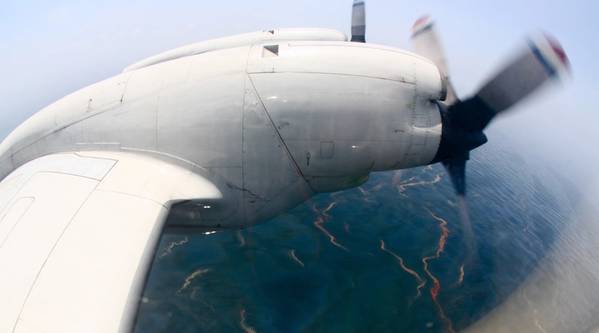
Scientists from the University of Miami Rosenstiel School of Marine & Atmospheric Science worked with National Oceanic & Atmospheric Administration (NOAA) researchers to find two plumes of oil-based pollutants downwind of the BP Deepwater Horizon oil spill.
In a study published in the journal Science this week, the team of researchers discovered a new mechanism by which the crude oil traveled from the sea surface to the atmosphere. Although the mechanism was predicted four years ago, the discovery now confirms the importance of this mechanism and could change the way urban air quality is understood and predicted.
As scientists expected, the lightest chemicals in the oil evaporated within hours. But what surprised them was that heavier compounds -- ones with more carbon atoms per molecule -- in the oil took longer to evaporate, spread out further and contributed to most of the formation of air pollution particles.
The NOAA-led team collected data of atmospheric gas and aerosol concentrations during two flights, one on June 8 and one on June 10, aboard a specially equipped WP3 Orion aircraft.
The data revealed that two plumes of hydrocarbons were released into the air by the surface oil and from smoke from the burning of oil associated with the cleanup. The first was a narrower 1.8-mile-wide hydrocarbon plume downwind from the spill site. This was the result of “direct evaporation of fresh oil on the sea surface,” the team suggested.
The second, a larger 24-mile-wide plume, contained higher concentrations of organic aerosols and was “formed from vapors released from the oil and the condensation of their atmospheric oxidation products onto existing particles,” according to the study’s authors.
The researchers observed that methane and other light hydrocarbons dissolved in the water column, while other, less volatile components of crude oil, made their way to the surface and into the atmosphere.
Claire Paris, a UM Rosenstiel School assistant professor of Applied Marine Physics, working with another team of researchers, produced numerical simulations of the oil spill during and following the airborne measurements by the NOAA-led team.
Paris, the research team, and Meteorology and Physical Oceanography Research Associate Professor Villy Kourafalou were awarded a National Science Foundation RAPID grant in July 2010 to model the three-dimensional dynamics of the oil spill and assess its fate and extent.
The study provides researchers with a better understanding of the effects of air pollutants, and their secondary chemical counterparts on the environment, human health and climate change.
Organic aerosols (OA) make up nearly 50 percent of the air pollution particles in polluted US cities. Air pollution particles can damage lung and heart function, and also affect the climate, with some aerosol, including OA, partially offsetting the warming from greenhouse gases by reflecting incoming sunlight or changing cloud properties, and other aerosol amplifying warming by increasing the amount of sunlight absorbed in the atmosphere.
De Gouw said his team knew where to expect OA particles downwind from the oil spill based on conventional understanding. OA forms when the most lightweight (volatile) components of surface oil evaporate, undergo chemical reactions, and condense onto existing airborne particles.
Roughly 30 percent of the surface oil fell into this volatile category, evaporating into the atmosphere within hours, the new analysis showed. That gave it little time to spread out, so emissions came from the area immediately surrounding the spill. A steady wind drew those emissions into a thin, linear streak of pollution in which organic aerosol was expected to form.
So he and his colleagues set out to figure out what else might have contributed to the pollution particles. Atmospheric scientists, in 2007, had proposed that heavier (less-volatile) components could theoretically help to create OA, but it had proven to be near impossible to study this process in the real world.
Since the heavier components of oil take longer to evaporate, they have more time to spread on the surface farther from the spill source than the lightweight particles. When De Gouw and his colleagues ran a series of models showing how the oil spread across the Gulf, and how long it should take for various particles to evaporate, the results were clear.
The less-volatile compounds measured by instruments on the aircraft that took the data were the culprit. These heavier compounds are not measured in most air quality monitoring systems, which were designed to capture the conventional contributors to poor air quality. The findings could help scientists understand why there is more organic aerosols in the polluted atmosphere than they can explain.
The study, titled “Organic Aerosol Formation Downwind from the Deepwater Horizon Oil Spill” was published in the March 11 issue of the journal Science.
BP’s Deepwater Horizon oil rig exploded on 20 April 2010, killing 11 people and spilling millions of gallons of oil into the Gulf of Mexico, disrupting the regional economy and ecosystem for more than 6 months, as well as causing air pollution.
Source: redOrbit

